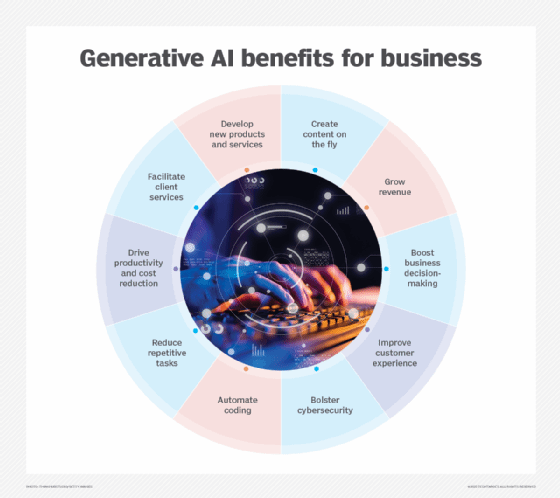
7 generative AI use cases in supply chain
Generative AI's demand forecasting and inventory optimization abilities, among others, can help companies meet their goals. Learn how the technology can align with these efforts.
Many company leaders are looking to integrate AI with their business processes to gain a competitive advantage in their industry, and generative AI can potentially help optimize key supply chain processes.
Generative AI (GenAI) is an emerging technology that is gaining popularity in various business areas, including marketing and sales. By analyzing an organization's data, GenAI can potentially improve operational efficiency and supply chain resiliency.
However, users should be aware of concerns surrounding what's known as AI hallucinations, which could hamper GenAI's ability to improve supply chain operations.
Learn more about generative AI and its specific use cases in the supply chain.
What is generative AI in the supply chain?
On the consumer level, the GenAI process consists of inputting a command or question into a text, image or video field, which prompts the AI to generate new content. GenAI models are typically trained on large-scale data sets, and when a user inputs fresh data, the application uses the new data and its previously learned knowledge to create new content.
Users can train GenAI on data that covers every aspect of the supply chain, including inventory, logistics and demand. By analyzing the organization's information, GenAI can help improve supply chain management and resiliency.

7 use cases for GenAI in the supply chain
Before moving forward with GenAI applications in the supply chain, supply chain leaders should consider which GenAI capabilities align with company objectives and assess applicable benefits and limitations.
Here are some use cases that hold potential promise for supply chain management.
1. Demand forecasting
The rapid shift in demand during the beginning of the COVID-19 pandemic, as consumers moved their spending away from services and toward goods, led to unpredictable supply chain operations. The shift demonstrated how important it is for companies to anticipate changes in demand.
Organizations can use GenAI models on historical sales data, market trends and other factors to simulate potential supply-and-demand scenarios and improve their demand forecasting accuracy. Tracking demand patterns can help organizations mitigate disruption and avoid stocking issues.
2. Inventory evaluation
GenAI can also potentially help improve inventory management as well.
GenAI that has been trained on key data such as stock levels, warehouse capacity and manufacturing time can suggest ways to optimize inventory processes, including recommending when to restock or reduce stock, which can help cut down on excess storage. Storing extra product costs companies more money, so reducing excess stock could cut down on costs.
3. Supplier and customer communication
Frequent communication between a company and its suppliers and between a company and its customers is key for an efficient supply chain, but making communication as effective as possible can be challenging.
GenAI can automatically send out messages, so employees don't have to. Large language models and natural language processing can consume data from sources like market events that might affect suppliers and traffic delays involving specific shipments, then GenAI chatbots can notify suppliers about risk. GenAI chatbots can also handle some customer queries, like processing a return or tracking a delivery.
4. Operations
New tech and fluctuating demand can lead to operational challenges, and GenAI can potentially suggest how to improve.
GenAI can assess aspects of operations like supplier performance and manufacturing speed, then suggest ways to optimize procedures. These optimizations can also potentially save companies money, among other benefits.
5. Logistics
Logistical disruptions can cause various issues. Traffic accidents can delay a shipment or extreme weather events can cause unexpected shortages, making it difficult to maintain on-time shipping schedules.
GenAI models with data such as historical weather patterns, traffic maps and fuel prices can identify routes for optimal travel and highlight potential upcoming disruptions as well as alternate routes if needed. Doing so can help shipping stay on schedule and improve customer service, since orders won't be delayed.
6. Sustainability and scalability
Sustainability is currently a major focus for many organizations, and GenAI can potentially highlight areas for improvement.
Training GenAI models on a company's current material use as well as market projections for renewable materials can give insight into how to make processes more sustainable while also considering cost-effectiveness and long-term scalability.
7. Analytics
GenAI can run simulations and potential what-if scenarios, assess risk and compile findings into a report.
As with all other GenAI supply chain use cases, caution is required when using the tech, as GenAI and the models that fuel it are still evolving. Current concerns include incorrect data and imperfect outputs, also known as AI hallucinations, which can prevent effective use.
Jacob Roundy is a freelance writer and editor, specializing in a variety of technology topics, including data centers and sustainability.







